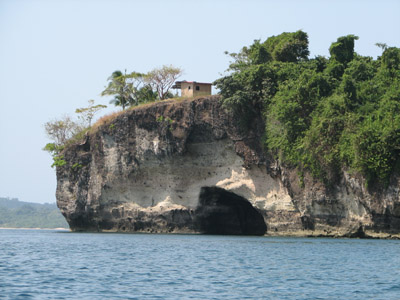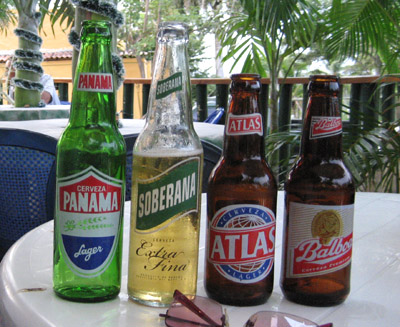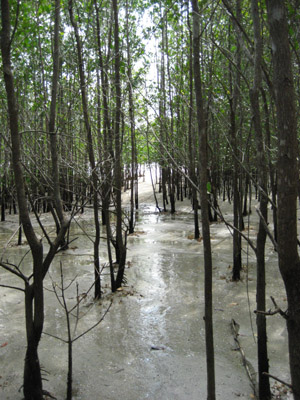
[A particularly accessible stand of mangroves at low tide on Coiba.]
Since leaving Coiba, we have been pretty much on the go, with only one or two stops where we tarried a whole day, going ashore, fretting over how few onions we had left and whether or not we would get scurvy because of it.
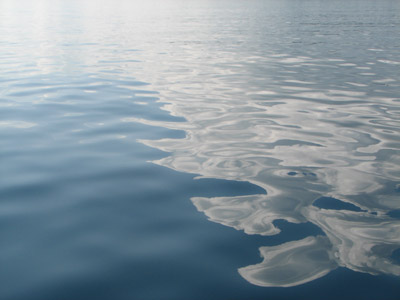
[No wind.]
Interestingly, the run between Coiba and Isla Cebago had more sea snakes than we’ve ever seen previously. We passed easily fifteen of them; on a couple of occasions we sailed right over the top of them and then they came out the back of the boat from between the main hull and ama looking really startled, flailing their tail in an effort to flee. Ahhh! Monsters! Not always did they choose the right direction however, and one snake went charging off right into the fishing lure we were dragging behind us, bonking into the lure as it went past, which of course freaked him out all over again. Sea snakes are very cool actually; I find it easy to harbor generous feelings towards the guys when I am not in the water with them.
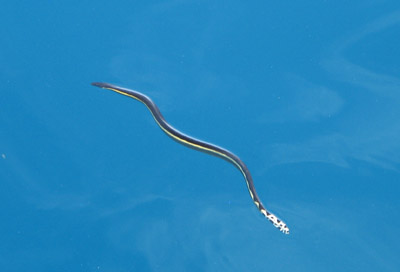
Wind has been highly sporadic our entire trip through western Panama, either there has been no wind whatsoever or else it has blown from exactly where we are headed. Also, we started getting northern squalls every day at around 4pm; invariably we would be headed east, then happily turn north into an anchorage when BAM, blast of north wind, rain, chop, poor visibility, and we’d have to tack back and forth for the last two or three miles in the failing light. Of course the moment we arrive into the anchorage, the wind would die and shift around to the west or something. Whatever. For our trip from Ensenada Naranjo over to Bucaro, we had zero wind whatsoever and an unbelievably uncomfortable confused chop until 4pm, when we came around Punta Guanico and it shifted to very strong out of the north (no accompanying squall though), which was exactly where we were trying to go at that point and had us wondering if we would make it before dark after all. The wind continued to blow strongly from the northeast the next day and we spent the day tacking back and forth across the bay over to Benao, the kick-off point for heading around Punta Mala and a very lovely anchorage with a beach full of cool seedpods and assorted plastic flotsam. The plan was to pull anchor by 4am the next morning for the haul around Punta Mala and into the Gulf of Panama.
Punta Mala has been the source of much discussion lately as well as extreme consternation on my part; it’s one of those points that everyone remembers distinctly going around. Point Bad. The issues are that there is a very strong current running south along the western side of the gulf (and we want to go north when we round the point), wind usually always blowing strongly from the north, which creates ugly seas (man, two strikes against our sailing direction), a geographic land sticky-outy thrust out in all this almost always works to intensify any wind/sea anomalies, and finally there are no decent anchorages on the other side for like 70 miles. So, once you make the point, you have many miles to go before you sleep, many bone-rattling, ass-numbing, and stomach-squashing miles at that. From what we hear, most people get around the point and just crank the motor, bashing straight north into it until they get far enough away from the point that conditions mellow out a little and they feel comfortable sailing again (supposedly this happens after 30 miles). We have read that if you do actually sail, you are probably better off heading directly for Islas Perlas, a clump of islands way out in the middle of the gulf 70 miles northeast of the point. Since our outboard prop sticks down in the water all of six inches, it was assumed that there would be no way we could motor even if we wanted to and so we figured we’d head directly for the Perlas (unless a miraculous east-northeast wind appeared and we could sail directly up the coast towards Panama City). To help counteract the prevailing current at the point, general advice says to round it on an incoming tide (which slows the current—it does not reverse it). All weather reports lately have said 10-15 knots per hour in the Bay of Panama. Except the last couple of days it had been 20-25.
So we awoke at 3am on Punta Mala Day when the boat started vibrating from some fresh northerly wind. We sort of half slept until the alarm went off at 4am and decided that it was just blowing way too hard; we’d hang out for the day and try to listen to the weather. Don, the SSB weather guy, said that if Benao was blowing 20, don’t even bother making the run around Punta Mala (it was blowing solid 15 with gusts to 20 at daybreak). Rains, on the other hand, says that the wind in Benao has absolutely nothing to do with what is going on at Punta Mala. What to do? We stayed another day doing random projects; I made myself a butterfly net. Boats were starting to stack up: Finisterre and Serenity were anchored with us and Claire de Lune and Icarian were on the way. We decided to try again the next morning and set the alarm for 4:30am; Serenity also was going to go for it. Again, the wind began blasting early; this time perhaps worse than the day before. We hemmed and hawed and stayed put but Serenity took off; we heard them later on the net saying that the winds were 25 knots at Punta Mala. Despite weather reports that this day was supposed to be milder than the previous, we had solid 20 with gusts to 25 in the anchorage. We were glad we didn’t leave.
Because of the tidal timing, we couldn’t just leave anytime—we had to time the point at low incoming tide, plus give ourselves two to three hours to get to the point from the anchorage. We had two tides per day—the early morning one and an afternoon tide, which would put us at the point around 5:30-6pm, a time when the wind had actually decreased in intensity the past two days. We decided that if the wind mellowed out a little by 2 or 3pm, we’d take off and make a night run around the point. It did mellow out and after fixing the motor yet again, we pulled anchor and rounded the corner out of Benao at 3:30pm.
The sail to the point was a straight shot close-hauled with winds gusting down over the land. We made really good time and were at the point in about two hours, where the wind had mellowed to about ten knots and the seas appeared surprisingly calm. We passed the point while I made Spanish tortilla for dinner. Seas and wind were still totally mellow and we were feeling like Mala was in the bag. Once we got around the point we found the current to be as strong as promised and it was pushing us around 30 to 40 degrees from what our boat was pointed; we decided to definitely go for the Perlas and put as much distance between us and the point as fast as possible. We put a VHF call to Finisterre back in Benao to brag over our genius timing for the Dread Punta Mala.
One hour and a half later, a mere five miles northeast of the point, the wind picked up. Like, a stiff 15-20, not altogether horrid but that’s also when the seas turned to shit. Just ugly, tossing, churning seas. Wind waves and swells and watery pointy monsters swashing in from all directions. The boat was suddenly very, very uncomfortable and I promptly got seasick. By that point it was dark and that just-gaze-at-the-horizon (longingly) thing works about as well as snake oil so I wedged myself in the bunk and gazed fixedly at Joshua at the helm instead.
One other detail of note: we were in fact rounding the point to enter the Gulf of Panama, where every single ship entering or exiting the Panama Canal on the Pacific side passes and so the first twenty or so miles was like a fun game of nighttime Frogger with all the freighter traffic. At one point, Joshua brightly informed me that we were dodging no fewer than six different freighters going in both directions.
Within an hour, we were double-reefed and the storm jib had replaced the working jib. We were still making twenty to thirty degrees off our course with the current and were only around eight miles from the point. The seas were getting really big and the wind had increased to 25 knots. We were making crap time too, maybe only 2.5 to 3 knots, because the walls of water knocking up against our bow and amas were efficient in halting forward progress. Joshua was still at the helm getting splashed with water every time a wave bounced up against the ama and I was still wedged in the bunk, that is, when I wasn’t having to get up to pee, which, curiously, happens with alarming frequency when I get seasick and nervous. Making the journey to the head when one is already feeling crappy is an exercise in misery and after four or five trips in quick succession, I spent all of my non-head-journeying time lying in the bunk worrying about when I would have to do it again. By morning I was so dehydrated I could hardly think straight.
Around three in the morning, the conditions peaked at around 30 knots of wind and snarly shite-fer-seas and Joshua figured out how to heave-to. This means you backwind one sail against the other and so it counters… and um turn the rudder over so that it, erm, the boat points into the sea and wind, mostly, and sort of takes care of itself. Something like that. Anyway, it worked pretty well; the boat really felt and sounded like it was taking a beating and now the motion through the water was better—more rolly and less jarring. Hove-to, we were actually making time in the right direction!
We were thirty miles out from the point by sunrise the next morning—this is supposedly when the current and wind effects from the point should dissipate. From what I could tell though, not much had changed. Winds were still around 20 knots and the seas still nasty. Neither of us had slept at all. Now that something that could be humorlessly construed as a horizon was visible, sometimes, I took over the helm/Frogger and Joshua passed out in the bunk, which was wet from salt water that had splashed onto the cabin and leaked in from the window (jeez!). The alarming motion of the boat was lessened by the fact that I was getting numb to it somewhat (Joshua assured me that we were not going to capsize and so I got to toss that worry to the bloody gale).
The wind and seas didn’t calm down for another 30 miles actually; that is, 60 miles beyond Punta Mala. I was driving along and suddenly there were all these large trees in the water. I dodged them for about 100 feet or so and then suddenly the boat shot out into smooth, regular water. (“Smooth” being used highly relative here.) No more random large mountainous waves knocking us sideways, just straightforward 17-hour gale-fed wind chop with 60 miles of fetch. Aaaahhhhh. It was 1:30pm. After a while Joshua woke up and took over steering some more and I actually managed to fall asleep for the first time. When I woke up, the working jib was back up and Joshua had the boat tuned so that it was sailing itself.
We arrived at Isla San Jose just after the sun set and headed up into the wide open Playa Grande to anchor. It was New Years Eve and we just happened to have a bottle of Sparkling Italian Muscat-esque wine on hand. Joshua rigged this up with a sock soaked in rubbing alcohol (we were going through an experimental phase with stove fuel in El Salvador and this was a reject we didn’t know what to do with) in an effort to cool it off. We made actual cooked food for the first time in twenty-four hours and passed out by 8pm, our champagne sock refrigeration system forgotten and dangling in the rigging.
